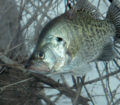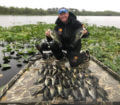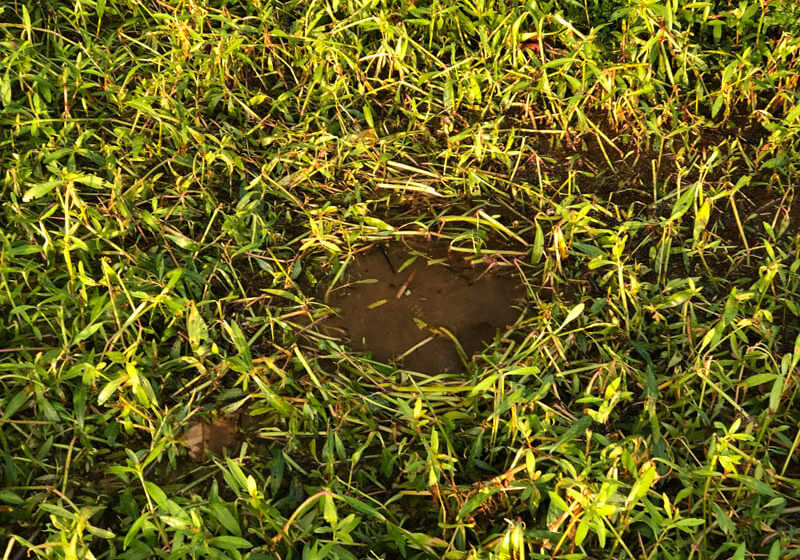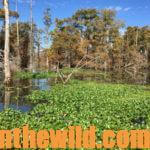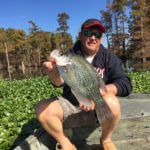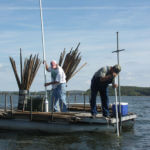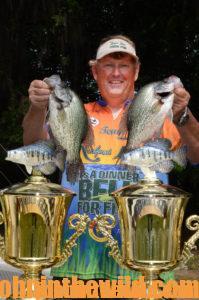 Editor’s Note: Whitey Outlaw from St. Matthews, South Carolina, has been fishing crappie tournaments for the last 40 years. He’s a third-generation crappie fisherman and consistently finishes in the top 15 in most of the tournaments he enters. Whitey’s home lake is Santee Cooper in South Carolina that was impounded from the Congaree River. Like most river systems, whether they’re dammed up or not, the Congaree was supported by a wide variety of creeks – often well away from the main river. Many of these creeks went through cypress and tupelo hardwood forests. So, when the river started backing up, these creeks were flooded and created what Outlaw calls, “The Swamp.” Many of these creeks became oxbow lakes that were cut off from the main river channel when the lake was impounded. The swamps that Outlaw fishes include Broadwater, McGirth’s Lake, Otter Flat and all the swamps attached to the main lake. However, most all rivers anywhere – whether they’re a part of a lake or a free-flowing stream – have creeks coming into them. Many of these creeks will have grass in them and often standing timber, just like they do at Santee Cooper in South Carolina.
Editor’s Note: Whitey Outlaw from St. Matthews, South Carolina, has been fishing crappie tournaments for the last 40 years. He’s a third-generation crappie fisherman and consistently finishes in the top 15 in most of the tournaments he enters. Whitey’s home lake is Santee Cooper in South Carolina that was impounded from the Congaree River. Like most river systems, whether they’re dammed up or not, the Congaree was supported by a wide variety of creeks – often well away from the main river. Many of these creeks went through cypress and tupelo hardwood forests. So, when the river started backing up, these creeks were flooded and created what Outlaw calls, “The Swamp.” Many of these creeks became oxbow lakes that were cut off from the main river channel when the lake was impounded. The swamps that Outlaw fishes include Broadwater, McGirth’s Lake, Otter Flat and all the swamps attached to the main lake. However, most all rivers anywhere – whether they’re a part of a lake or a free-flowing stream – have creeks coming into them. Many of these creeks will have grass in them and often standing timber, just like they do at Santee Cooper in South Carolina.
“The Swamp has a lot of shallow water in it, and we’ll often be fishing in 4–12 foot deep water,” Outlaw explains. “And, much of the swamp is covered with alligator grass, hyacinths and a wide variety of other grasses. We can catch crappie in the grass at any time of the year at Santee Cooper. Most crappie fishermen think about fishing the grass in the spring and possibly the summer months, but we also catch crappie in the grass during the fall and the winter.
“When grass begins to die in the fall and winter, it gives off heat – just like hay in a hay field does. You can go in the swamp in the morning and see fog rising off the 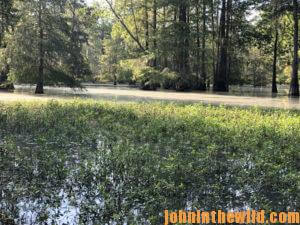 water because the heat the grass gives off is warmer than the air above the water. So, you know that the water where the grass is found is warmer than the cooler air of the fall and winter. Therefore, crappie will stay in that grass during the fall and winter, as well as in the spring and summer. Grass is always a good place to catch crappie, regardless of the time of the year.
water because the heat the grass gives off is warmer than the air above the water. So, you know that the water where the grass is found is warmer than the cooler air of the fall and winter. Therefore, crappie will stay in that grass during the fall and winter, as well as in the spring and summer. Grass is always a good place to catch crappie, regardless of the time of the year.
“Because the water’s warmer in the winter in dead and dying grass, the baitfish that the crappie feed on also will be there. There’ll be insects, freshwater shrimp and all types of critters too that crappie feed on in that grass. In the summertime, the grass is often cooler than the water in the main part of the river, due to the grass providing shade and oxygen and an ambush point where crappie can hide and attack baitfish and insects.”
 Outlaw digs holes in the grass, so that his jigs can drop into those holes and fall all the way to the bottom. According to Outlaw, “The holes we dig will be about the size of the bottom of a soda can – just big enough to allow a 1/16-ounce jig to fall from the surface to the bottom. When we catch a crappie in one of those holes, as they fight, they’ll make the hole bigger when we pull them out of the hole. Look at your fist, and that’s about the size of the hole we’re digging in the grass. Once we catch a crappie, its head can come through that hole that we’ve dug, and when we get the crappie’s head through the hole, the rest of its body will make the hole bigger.
Outlaw digs holes in the grass, so that his jigs can drop into those holes and fall all the way to the bottom. According to Outlaw, “The holes we dig will be about the size of the bottom of a soda can – just big enough to allow a 1/16-ounce jig to fall from the surface to the bottom. When we catch a crappie in one of those holes, as they fight, they’ll make the hole bigger when we pull them out of the hole. Look at your fist, and that’s about the size of the hole we’re digging in the grass. Once we catch a crappie, its head can come through that hole that we’ve dug, and when we get the crappie’s head through the hole, the rest of its body will make the hole bigger.
“There’re many different tools you can use to dig the holes. The two I’ve settled on seem to be the most efficient. I like a 10-foot piece of half-inch shallow-wall conduit cable that electricians use. I use a pipe bender to create a 12-inch bend on the end of the conduit, and that size tool seems to work best to dig holes in the grass at any time of the year. Sometimes the grass where we dig holes will be a foot thick at different times of the year. So, when I put the conduit in the water, it’s got to be strong enough and have a bend big enough to move 12 inches of grass. When I’m digging a hole, I use my conduit tool to pull grass forward and to push grass back to create my holes. I don’t pull any of the grass out of the hole. I just want that hole to be big enough for my jig to drop through the hole without getting tangled in any grass before it reaches the bottom.
“One of the questions I’m often asked is, ‘How quickly can you fish the hole you’ve just dug and expect to catch crappie in it?’ During the spring when the crappie are really fired-up and hungry, often you can catch crappie out of that hole just as quickly as you can create it. The crappie will attack and eat anything that drops through a hole in the grass. You’ve got to remember that a crappie is always looking for something to eat. Therefore, when there’s a little disturbance in the water, that causes a lot of critters that may be concentrating in the grass to start to fall. So, getting bites and catching crappie as soon as I make the hole in the grass during the spring and the fall isn’t uncommon.
“The jig I use is called a Rockport Rattler. Another advantage that this particular jig has is that it has an eye inside that’s cut with a machine used to cut diamonds and has different facets of cuts and angles in it. So, the eye glitters in the water, allowing the fish to see the eye of the jig really well. This jig is the only crappie jig I know of with a rattle in it. It also has a No. 4 hook and the jig is made by Chicky Tackle company (https://chickytackle.com/).
“Friends and I use a wide variety of colors and jig bodies. Pink, orange and chartreuse are three of my favorite colors. The bodies we like include the Slider jig made by the Charlie Brewer Slider Company (https://www.sliderfishing.com/) in the 1-inch size or the 1-1/2-inch size. We also like the Crappie Magnet bodies made by Trout Magnet and Crappie Magnet (https://troutmagnet.com/). This technique of digging holes and catching crappie all year long has produced crappie all over the nation and tends to produce both black and white crappie depending on which variety of crappie is most dominant in the lake you fish. Anywhere in the nation you find grass, digging holes for crappie will work.”
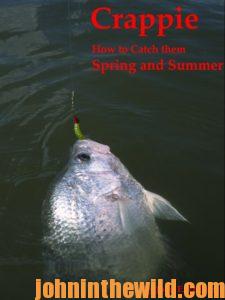 To learn more about crappie fishing, check out John E. Phillips’ book, “Crappie – How to Catch Them Spring and Summer,” available in Kindle, print and Audible versions at http://amzn.to/WGaJLT.
To learn more about crappie fishing, check out John E. Phillips’ book, “Crappie – How to Catch Them Spring and Summer,” available in Kindle, print and Audible versions at http://amzn.to/WGaJLT.
Tomorrow: How many Holes to Dig and How Many Crappie You Can Expect to Catch from Each Hole

